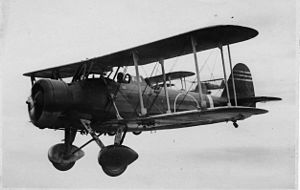Aichi D1A Video - Picture

|
|
Aichi D1A
Aichi D1A

Role: Dive bomber
Manufacturer: Aichi Kokuki KK
First flight: 1930s
Retired: 1942
Primary user: IJN Air Service
Number built: Total - 590
D1A1 - 162
D1A2 - 428
The Aichi D1A or Navy Type 94/96 Carrier Bomber (Allied reporting name "Susie") was a Japanese carrier-based dive bomber of the 1930s. A single-engine, two-seat biplane based on the Heinkel He 50, it was produced by Aichi for the Imperial Japanese Navy, remaining in service as trainers at the time of the attack on Pearl Harbor. The D1A was produced in two variants, the D1A1 (Navy Type 94 Carrier Bomber), and the D1A2 (Navy Type 96 Carrier Bomber, sometimes referred to as the D2A.)
Design and development
The D1A came out of the Imperial Japanese Navy's need for an advanced carrier-based dive bomber, and in late 1934 the IJN ordered the finalisation of the Aichi AB-9 design which was produced as the early model D1A1. However, the D1A1 was not designed by Aichi Tokei Denki Kabushiki Kaisha aircraft company, but by Ernst Heinkel Flugzeugwerke at the request of the Aichi company. The initial version designed by Heinkel was the He 50, a similar model equipped with floats instead of landing gear. The subsequent model, the He 66 was provided to Aichi who immediately began production of it as the D1A1.
The design of the D1A was based on the He 66 and was designed as a biplane constructed of metal, with a fabric covering, a fixed landing gear and a conventional type tail landing skid. Original models had 365 kW (490 hp) engines and it was not until later models that more powerful 433 kW (580 hp) engines were included in the construction.
Operational history
The D1A was primarily used in the Second Sino-Japanese War and up to the time Japan entered World War II in 1941. At the beginning of the Pacific War, all of the remaining D1A1s were decommissioned and most of the D1A2s were retired from the front lines and served primarily in training units. The exception was 68 of the D1A2 model that operated as a second-line support until being retired in 1942.
Variants
D1A1 Type 94 Powered by 433 kW (580 hp) Nakajima Kotobuki 2 Kai 1 or Kotobuki 3 radial engines; 162 built . D1A2 Type 96 (Sometimes referred to as the D2A) Improved version fitted with spatted wheels and a higher powered Nakajima Hikari 1 engine; 428 built .
Operators
Japan
Imperial Japanese Navy Air Service
Specifications (D1A2)
Data from
General characteristics
Crew: 2: pilot and gunner
Length: 9.3 m (30 ft 6â…› in)
Wingspan: 11.4 m (37 ft 4¾ in)
Height: 3.41 m (11 ft 2¼ in)
Wing area: 34.7 m² (374 ft²)
Empty weight: 1,516 kg (3,342 lb)
Loaded weight: 2,500 kg (5,512 lb)
Max takeoff weight: 2,610 kg (5,754 lb)
Powerplant: 1x— Nakajima Hikari 1 nine-cylinder radial engine, 730 hp (545 kW)
Performance
Maximum speed: 309 km/h (171 kn, 192 mph)
Range: 927 km (498 nmi, 576 mi)
Service ceiling: 6,980 m (22,900 ft)
Rate of climb: 6.37 m/s (1,253.94 ft/min)
Wing loading: 72.0 kg/m² (14.7 lb/ft²)
Power/mass: 0.22 kW/kg (0.13 hp/lb)
Armament
Guns:
2x— fixed 7.7 mm (.303 in) Type 92 machine guns
1x— flexible 7.7 mm (.303 in) Type 92 machine gun
Bombs:
1x— 250 kg (551 lb) bomb under fuselage
2x— 30 kg (66 lb) bombs under wings
Related development
Heinkel He 50
Francillon, R.J. (1970). Japanese Aircraft of the Pacific War. London: Putnam. ISBN 370 00033 1.
Chant, Chris (1999). Aircraft of World War II - 300 of the World's Greatest aircraft 1939-45. Amber Books Lts. ISBN 978-0-7607-1261-0.
Aichi D1A Pictures and Aichi D1A for Sale.
Living Warbirds: The best warbirds DVD series.
Source: WikiPedia